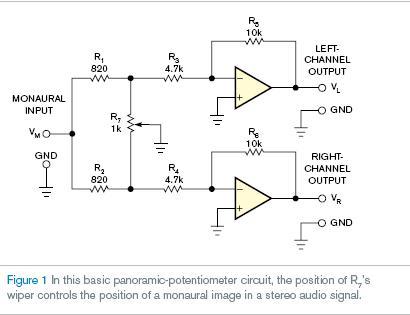在立体声领域,改进控制电路放置非立体声像。
在混和音频应用中,一个频繁需要的功能是将一个非立体声或单通道声源混到一个立体声场中。音频工程师们所说的全景电位计电路,是一种可从一个单声道信号产生具有标准波幅的左、右信号,并能将信号的声像放在立体声场中任何位置的电路。由于声像的响度似乎与其最终位置无关,起源的左、右信号必须相加,以产生一个功率恒定的信号,而不是一个电压恒定的信号。
图1中广泛使用的电路完成这样的功能。通过区分两个立体声声道之间的单声道信号和在0和M之间改变每个声道的增益,例如在R7的中心位置,每个声道的增益为0.707M。如果计算实现这些条件的器件值,电路表现出显著的特性。对R7抽头的所有位置,左右声道的功率之和持续在不超过0.19dB。

可以用一个DPDT开关S1将电路旁路,从音频链中隔离开(图2)。另一种方法,可以增加两个电阻,用一个SPST开关禁止或使能电路。图3与图1中电路有相同的增益特性。闭合开关S1使能全景电位计功能,而断开开关产生一个固定的中心声像。另外,从实用角度看,图3电路简化了接线,也不会引入明显的开关瞬时噪声,因为使能全景电位计功能只是将R7的抽头接地。即使使用推荐值元件时和忽略元件公差时,电路产生的最大增益误差也只有0.21dB。


英文原文:
Add simple disable function to a panoramic-potentiometer circuit
Improved control circuit places monaural image in a stereo field.
Lawrence Mayes, Malvern, United Kingdom; Edited by Brad Thompson and Fran Granville -- EDN, 2/15/2007
In audio-mixing applications, one frequently required function involves mixing a monaural or single-channel source
into a stereo-sound field. Audio engineers refer to a panoramic-potentiometer circuit as a circuit that generates left and right signals of correct amplitudes from a monaural signal and places the signal's image anywhere in a stereo-sound field. For the image's loudness to appear independent of its final position, the derived left and right signals must add to produce a constant-power signal rather than a constant-voltage signal.
The widely used circuit in Figure 1 performs this function by dividing the monaural signal between the two stereo channels and varying each channel's gain between zero and M such that at R7's centered position, each channel's gain is 0.707M. If you calculate component values to achieve these conditions, then the circuit presents the remarkable property that, for all positions of R7's wiper, the sum of the powers in the left and right channels is constant to within 0.19 dB.
You can use a DPDT switch, S1, to bypass the circuit and thus remove it from the audio chain (Figure 2). As an
alternative, you can add two resistors and use an SPST switch to disable or enable the circuit. The circuit in Figure 3 presents the same gain characteristics as in Figure 1. Closing switch S1 enables the panoramic-potentiometer function, and opening the switch produces a fixed central-sound image. Additionally, from a practical viewpoint, the circuit of Figure 3 simplifies wiring and introduces no significant switching transient because enabling the panoramic-potentiometer function involves only grounding R7's wiper. Even when you use preferred-value components and disregard component tolerances, the circuit introduces a maximum gain error of only 0.21 dB.

 我要赚赏金
我要赚赏金

